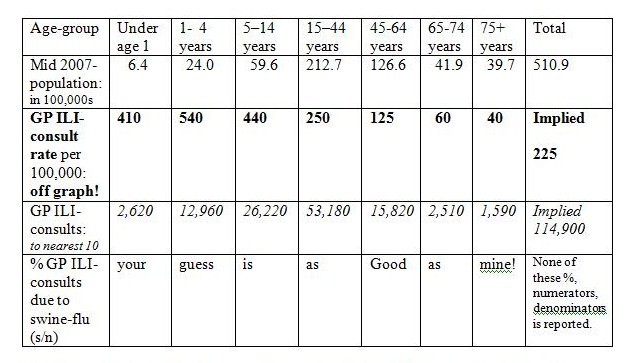Parents unduly alarmed by H1N1 reports
The latest figures on H1N1 infections in England, released yesterday by the Health Protection Agency, have led to some misleading headlines.
Both The Times and The Independent declare that the under-14s have been worst-hit, but they have been misled by the way the HPA has presented the data – or failed to provide all the data needed.
The published figures relate to the GP consultation rate for influenza-like ilnesses (ILIs). This is indeed highest in the younger age groups, but these represent less than a fifth of the population. If we compare instead the actual number of ILI-consultations, most are in the 15-44 age group.
The HPA announced that “GP consultation rates have increased sharply over the last week” in England, and estimated there had been 100,000 new cases of swine flu in England “last week” (range 60,000 – 140,000) compared to 55,000 new cases in the previous week (range 30,000 – 85,000). Which week was “last week”?
The latest QSurveillance data on GP consultation rates for influenza-like-illnesses as presented by the HPA in its release on 23 July, are for week 29: 13-19 July. The data by age-group, which I've had to read off an HPA graph, are tabulated below.

Notice that the age-groups relate to vastly different population numbers, as the accompanying mid-2007 population estimates for England emphasise. The HPA did not provide these...
The GP ILI-consultation rates are highest in the under-14s, but the vast majority of GP's ILI consultations were persons between 15 and 44.
Today’s Times reported: “under-14s the worst hit” . . . correct in terms of ILI-consultation-rates, wrong in terms of actual numbers if ILI-consultations. Parents may be unduly alarmed by this failure to report the age-distribution for consultations in additioon to the age-specific consultations rates. This matters when, as in the Table, the age groups reported upon differ dramatically in their associated population size. The HPA does not sufficiently alert the reader.
The implied total for GP ILI-consultations in the above table is suspiciously close to HPA’s central estimate of 100,000 but cannot, surely, be the source of it because not all GP consultations about ILIs are swine-flu. Indeed, the swine flu percentage is likely both to be modest and to vary across the age-groups. We should be told, not treated as innumerate!
After the UK stopped doing routine virological confirmation of suspect H1N1 cases, the Chief Medical Officer suggested that a ‘small sample’ only of ILIs would continue to be tested.
Sir Liam, how small are the sample sizes per age-group, and how representative are the folk swabbed for H1N1 confirmation of all those who, for example, consulted their GP about an influenza-like illness? Not all consultees even attend the GP’s surgery – in fact, for the sake of infection control, we very much hope that most don’t! And GPs will rightly prioritize their visits on the basis of clinical need.
Let's hope for better statistical reporting standards from the HPA in the near future. Still no data on incident, rather than prevalent, hospitalisations. In successive weeks, the in-hospital cases for England have been reported as 335, 652, and 840 (report, 23 July). Still no data on the age and sex of England's H1N1-related deaths.
Readers should compare the weekly updates on H1N1 by HPA and Health Protection Scotland.



